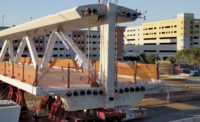Older cranes without a full complement of modern safety and data-recording devices should be phased out in New York City and replaced by more recently made machines, according to a new interim report from a crane safety working group appointed after New York City’s latest crane accident.
The Crane Safety Technical Working Group recommends that the New York City Council adopt a pending bill that would impose an age limit on cranes working in the city’s five boroughs.
Phasing out old cranes will make way for “cranes with newer technology and safety features,” the report states.
The proposed age limit is one of a bucketful of recommendations featured in the working group’s 56-page interim report.
The working group also calls for all cranes in the city to be equipped with anemometers, data-logging "black boxes" and GPS tracking “so that cranes can be more closely monitored."
The recommendations are the latest effort to make a meaningful improvement in crane safety in a city that has become known for tragic crane accidents.
The latest high-profile accident involved a crawler crane with a 565-ft-long boom and jib that crashed to the ground in lower Manhattan on February 5th, killing a 38-year old mathematician, David Wichs. Winds were gusting at the time of the accident, and the operator was apparently securing the crane and crews on the ground were clearing the street of pedestrians.
While wind speed is a factor, technical failure or human error also could have played a role, crane experts told ENR. Some speculated that the crane crew may had started securing the crane too late.
New Crane Safety Regulations
Three days after the February accident, Mayor Bill de Blasio announced new safety regulations lowering the maximum wind speed at which the cranes may operate, to a sustained 20 mph or gusts of 30 mph. Previously, crane operation could continue until steady wind speeds hit 30 mph or gusts reached 40 mph.
In March, New York City updated its regulations after the working group recommended returning to the previous rule, requiring contractors and crane operators to observe a crane’s wind rating or stop work when winds hit 30 mph.
De Blasio and Buildings Commissioner Rick Chandler established the Crane Safety Technical Working Group after the February crane collapse. When the as-yet-unfinished investigation into that accident is done, the working group will issue a final report.
The working group’s interim report also calls for additional oversight of cranes, including inspections prior to use each day, “similar to how airplanes are readied for flight."
Contractor associations could not be reached at ENR press time for comment.




